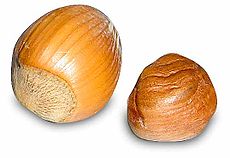- Tree nut allergy
-
Tree nut allergy Classification and external resources 
HazelnutsICD-9 995.64, V15.05 MeSH D021184 Tree nut allergy is one of the most common types of food allergy, affecting millions of people worldwide. It is a hypersensitivity to dietary substances from tree nuts causing an overreaction of the immune system, which may lead to severe physical symptoms[1]. Tree nuts include almonds, Brazil nuts, cashews, chestnuts, filberts/hazelnuts, macadamia nuts, coconut, pecans, pine nuts (pignolia nuts), pistachios, and walnuts.
People with tree nut allergy are seldom allergic to just one type of nut, and are therefore usually advised to avoid all tree nuts, even though an individual may not be allergic to all varieties of tree nuts. Someone allergic to walnuts or pecans may not have an allergy to cashews or pistachios, even though close biological relatives often share related allergenic proteins. The severity of the allergy varies from person to person, and exposure can increase sensitization. For those with a milder form of the allergy, the raw nut protein usually causes a more severe reaction than the oil, and extra roasting or processing can reduce the allergic reaction. Those diagnosed with anaphylaxis will have a more immediate mast cell reaction and be required to avoid all exposure to any allergen-containing products or byproducts, regardless of processing, as they are prone to even greater sensitivity. An allergy test or food challenge may be performed at an allergy clinic to determine the exact allergens. New immunotherapy treatments are being developed for tree nut allergy.
Tree nut allergy is distinct from peanut allergy, as peanuts are considered legumes, whereas a tree nut is a hard-shelled fruit of certain plants.
This allergy tends to be life-long; recent studies have shown that only about 9% of children outgrow their tree nut allergy[1].
Hazelnut has been used as a model tree nut in the study of tree nut allergies.[2]
Contents
Prevention and treatment
In the United States, the federal Food Allergen Labeling and Consumer Protection Act (FALCPA) requires that any packaged food product that contains tree nuts as an ingredient must list the specific tree nut on the label[1]. Foods that almost always contain tree nuts include pesto, marzipan, Nutella, baklava, pralines, nougat, gianduja, and turrón. Other common foods that may contain tree nuts include cereals, crackers, cookies, baked goods, candy, chocolates, energy/granola bars, flavored coffee, frozen desserts, marinades, barbecue sauces, and some cold cuts, such as mortadella. Tree nut oils (especially shea nut) are also sometimes used in lotions and soaps. Asian and African restaurants, ice cream parlors, and bakeries are considered high-risk for people with tree nut allergy due to the common use of nuts and the possibility of cross contamination.
Treatment usually involves an exclusion diet and vigilant avoidance of foods that may be contaminated with tree nuts, nut particles, or oils. The most severe nut allergy reaction is anaphylaxis,[3] an emergency situation requiring immediate attention and treatment with epinephrine.
See also
- Allergy
- List of allergies
- Anaphylaxis
- Food allergy
- Asthma
- Peanut allergy
References
- ^ a b c National Institutes of Health, NIAID Allergy Statistics http://www3.niaid.nih.gov/topics/foodAllergy/understanding/quickFacts.htm
- ^ Birmingham NP, Parvataneni S, Hassan HM, et al. (2007). "An adjuvant-free mouse model of tree nut allergy using hazelnut as a model tree nut". Int. Arch. Allergy Immunol. 144 (3): 203–10. doi:10.1159/000103993. PMID 17570928. http://content.karger.com/produktedb/produkte.asp?typ=fulltext&file=000103993.
- ^ National Report of the Expert Panel on Food Allergy Research, NIH-NIAID 2003 http://www3.niaid.nih.gov/about/organization/dait/PDF/june30_2003.pdf
External links
- Tree nut allergy at Food Allergy Initiative
- "Are Nut Bans Promoting Hysteria?" by Tana Parker-Pope at The New York Times (15 Dec 2008)
Health science - Medicine - Allergic conditions Respiratory system Allergic rhinitis · Asthma · Hypersensitivity pneumonitis · Eosinophilic pneumonia · Churg-Strauss syndrome · Allergic bronchopulmonary aspergillosis · Farmer's lung · Laboratory animal allergySkin Blood and immune system Circulatory system Digestive system Nervous system Eosinophilic meningitisGenitourinary system Other conditions Immune disorders: hypersensitivity and autoimmune diseases (279.5–6) Type I/allergy/atopy
(IgE)ForeignAtopic dermatitis · Allergic urticaria · Hay fever · Allergic asthma · Anaphylaxis · Food allergy (Milk, Egg, Peanut, Tree nut, Seafood, Soy, Wheat), Penicillin allergyAutoimmunenoneType II/ADCC
(IgM, IgG)ForeignAutoimmuneAutoimmune hemolytic anemia · Idiopathic thrombocytopenic purpura · Bullous pemphigoid · Pemphigus vulgaris · Rheumatic fever · Goodpasture's syndromeType III
(Immune complex)ForeignHenoch–Schönlein purpura · Hypersensitivity vasculitis · Reactive arthritis · Rheumatoid arthritis · Farmer's lung · Post-streptococcal glomerulonephritis · Serum sickness · Arthus reactionAutoimmuneType IV/cell-mediated
(T-cells)ForeignAutoimmuneUnknown/
multipleForeignAutoimmuneSjögren's syndrome · Autoimmune hepatitis · Autoimmune polyendocrine syndrome (APS1, APS2) · Autoimmune adrenalitis · Systemic autoimmune diseaseCategories:- Edible nuts and seeds
- Food science
- Food allergies
Wikimedia Foundation. 2010.
